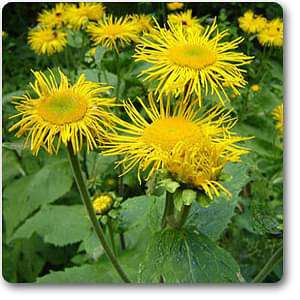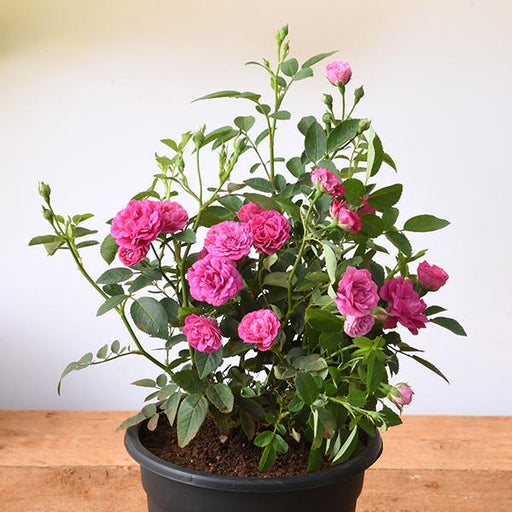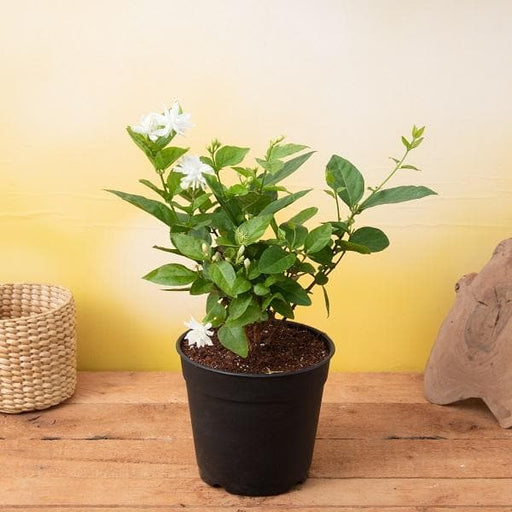
Elecampane - Plant
(MRP Inclusive of all taxes)
- Shipping ₹79 for entire order
- Dispatch in 7 days
- Country of origin: India

(MRP Inclusive of all taxes)
 Save 29%
Save 29%
Air Purifier Money Plant with Pot The Air Purifier Money Plant, also known as Pothos or Epipremnum aureum, is a stunning indoor plant that...
View full details
 Save up to 15%
Save up to 15%
Peace Lily, Spathiphyllum - Plant The Peace Lily, scientifically known as Spathiphyllum, is a stunning houseplant celebrated for its elegant white...
View full details
 Save 25%
Save 25%
Jasminum sambac, Mogra, Arabian Jasmine - Plant Jasminum sambac, commonly known as Mogra or Arabian Jasmine, is a fragrant flowering plant...
View full details
 Save 18%
Save 18%
Combo Constituents Includes the Parijat Tree (Night-Flowering Jasmine), a culturally significant plant with fragrant flowers. Description The Pari...
View full details
 Save 25%
Save 25%
Miniature Rose, Button Rose (Any Color) - Plant The Miniature Rose, also known as the Button Rose, is a charming and compact flowering plant that ...
View full details Save 25%
Save 25%
Damascus Rose, Scented Rose (Any Color) - Plant The Damascus Rose, also known as Rosa damascena, is a timeless symbol of beauty and romanc...
View full details
 Save 17%
Save 17%
Beautiful Fragrant Mogra, Arabian Jasmine Plant with Pot The Beautiful Fragrant Mogra, also known as Arabian Jasmine (Jasminum sambac), is...
View full details Save 15%
Save 15%
Pack of Vermicompost and Neem Cake for House Plants Transform your indoor garden with our premium Pack of Vermicompost and Neem Cake, spec...
View full details
Pack of Plant Growth and Flower Boosters Unlock the full potential of your garden with our Pack of Plant Growth and Flower Boosters! This ...
View full details Save 38%
Save 38%
Combo of Jeevamrut and Neem Raksha for Easy Growth and Protection of Houseplants Transform your indoor garden with our exclusive combo of ...
View full details Save 22%
Save 22%
Plant Nutrients Kit (Pack of 16) for a Healthy Garden Transform your garden into a lush paradise with our Plant Nutrients Kit, featuring 1...
View full details Save 16%
Save 16%
Combo of Top Plant Fertilizers Elevate your gardening game with our exclusive Combo of Top Plant Fertilizers, featuring two bags of premiu...
View full details Save 24%
Save 24%
Pack of 4 Additives to Make Soil Healthy and Nutrient Rich Transform your garden into a thriving ecosystem with our Pack of 4 Additives de...
View full details Save 30%
Save 30%
Transform your gardening experience with our premium Combo of Perlite and Vermiculite. This unique blend is designed to enhance soil aeration and ...
View full details Save 27%
Save 27%
Combo of 2 Vermicompost and Cocopeat - Enrich Your Soil Naturally! Transform your garden into a thriving ecosystem with our Combo of 2 Ver...
View full details
 Save 35%
Save 35%
Best 6 Plants for Perfect Indoor Garden Transform your living space into a lush oasis with our curated collection of the Best 6 Plants for a...
View full details
 Save up to 50%
Save up to 50%
Mini Succulent Garden Pack Transform your space with our Mini Succulent Garden Pack, featuring a delightful collection of 4 any variety beautiful s...
View full details
 Save 30%
Save 30%
5 Best Fragrant Plants Transform your garden or indoor space into a fragrant paradise with our curated selection of the 5 Best Fragrant Plants. Th...
View full details
 Save 24%
Save 24%
Set of 2 Bonsai Looking Grafted Adeniums Transform your indoor or outdoor space with our exquisite Set of 2 Bonsai Looking Grafted Adenium...
View full details Save 45%
Save 45%
Top 4 Die Hard Succulents Pack Transform your indoor or outdoor space with our Top 4 Die Hard Succulents Pack, featuring a curated selecti...
View full details
 Save 30%
Save 30%
5 Best Indoor Plants Pack Transform your living space into a lush oasis with our '5 Best Indoor Plants Pack.' This carefully curated collection fe...
View full details
 Save 25%
Save 25%
Set of 4 Evergreen Air Purifier Plant Pack Transform your indoor space into a lush, green oasis with our Set of 4 Evergreen Air Purifier Pla...
View full details| SrNo | Item Name |
|---|---|
| 1 | Elecampane - Plant |
Elecampane (Inula helenium) is a perennial herb native to Europe and Asia, renowned for its striking yellow flowers and tall stature, reaching up to 6 feet. This hardy plant thrives in a variety of soil types and is often found in meadows and along roadsides. Historically, Elecampane has been used in traditional medicine for its expectorant and anti-inflammatory properties, making it a valuable addition to any herbal garden.
What makes Elecampane special is its rich history in herbal medicine, dating back to ancient Greece and Rome. It was used by Hippocrates and later by herbalists throughout the Middle Ages. Its roots contain inulin, a prebiotic that supports gut health, and its essential oils are known for their antimicrobial properties. This plant not only enhances your garden's beauty but also offers numerous health benefits.
One of Elecampane's standout features is its ability to attract pollinators, such as bees and butterflies, making it an excellent choice for eco-friendly gardens. Additionally, its deep roots help prevent soil erosion, contributing positively to the environment.
If you think Elecampane is just a pretty face in the plant world, think again! This herbaceous perennial is a powerhouse packed with benefits. From soothing respiratory issues to acting as a digestive aid, Elecampane is like that friend who always has your back. Its roots are rich in inulin, a prebiotic that promotes gut health, while its anti-inflammatory properties can help ease those pesky coughs. So, next time you’re feeling under the weather, consider inviting Elecampane to your herbal tea party!
Elecampane is not picky; it’s the life of the garden party! Thriving in moist, well-drained soil and full sun, this plant is like the extrovert of the botanical world. It can handle a bit of shade, but let’s be honest, it prefers to bask in the limelight. With a little love and attention, Elecampane will reward you with tall, striking flowers that can reach up to 6 feet. Just remember, it’s a perennial, so it’ll keep coming back for more!
What can’t Elecampane do? This versatile plant is like the Swiss Army knife of the herbal world. Traditionally used in herbal medicine, it’s known for its expectorant properties, making it a go-to for coughs and colds. But wait, there’s more! Elecampane can also be used in tinctures, teas, and even as a flavoring in certain dishes. It’s the culinary chameleon you didn’t know you needed. So, whether you’re brewing a soothing tea or spicing up your dinner, Elecampane is ready to shine.
If you haven’t tried Elecampane tea, you’re missing out on a delightful herbal experience! This brew is not just a drink; it’s a warm hug in a cup. With its earthy flavor and a hint of sweetness, Elecampane tea is perfect for those chilly evenings when you need a little comfort. Plus, it’s packed with health benefits, making it a guilt-free indulgence. So, steep some Elecampane roots, sit back, and let the soothing properties work their magic. Your taste buds will thank you!
When it comes to cough remedies, Elecampane is the unsung hero of the herbal world. This plant has been used for centuries to help clear the airways and soothe that annoying tickle in your throat. Its expectorant properties work wonders, making it easier to expel mucus and breathe easier. So, if you find yourself in a coughing fit, don’t reach for the cough syrup just yet. Instead, brew a cup of Elecampane tea and let nature do its thing. Your lungs will be singing your praises!
The root of Elecampane is where the magic happens! Packed with beneficial compounds, this root is the star of the show when it comes to herbal remedies. It’s rich in inulin, which not only supports gut health but also acts as a natural sweetener. Plus, it’s known for its anti-inflammatory and antimicrobial properties. So, whether you’re using it in a tincture or steeping it for tea, Elecampane root is the herbal powerhouse you want in your corner. It’s like the secret ingredient in your favorite recipe!
Elecampane has a rich history in traditional medicine, and it’s not just a passing fad. Used by herbalists for centuries, this plant has earned its stripes as a reliable remedy for various ailments. From respiratory issues to digestive troubles, Elecampane has been the go-to herb for many cultures. Its historical significance adds a layer of charm, making it not just a plant, but a part of our herbal heritage. So, when you sip on that Elecampane tea, you’re not just enjoying a drink; you’re partaking in a time-honored tradition!
If allergies have you feeling like a sneezy mess, Elecampane might just be your new best friend. This herb is known for its anti-inflammatory properties, which can help alleviate allergy symptoms. By soothing the respiratory system, Elecampane can make those pesky pollen days a little more bearable. So, before you reach for the antihistamines, consider giving Elecampane a try. It’s like having a natural bodyguard against those seasonal sniffles!
Elecampane is not just a medicinal marvel; it’s also a stunning addition to any garden! With its tall stature and vibrant yellow flowers, this plant is like the showstopper of the garden bed. It attracts pollinators, making it a favorite among bees and butterflies. Plus, it’s relatively low-maintenance, so you can enjoy its beauty without the stress of constant care. Plant Elecampane, and watch your garden transform into a lively ecosystem. It’s the botanical equivalent of throwing a fabulous party!
Who knew Elecampane could be a skincare superstar? This herb is not just for sipping; it can also work wonders for your skin. With its anti-inflammatory and antimicrobial properties, Elecampane can help soothe irritated skin and promote a healthy complexion. Whether used in creams, ointments, or infused oils, this plant is like a spa day in a bottle. So, if you’re looking to elevate your skincare routine, consider adding Elecampane to your beauty arsenal. Your skin will be glowing with gratitude!
Looking to shed a few pounds? Elecampane might just be the herbal ally you didn’t know you needed! Known for its digestive benefits, this plant can help regulate metabolism and promote healthy digestion. Plus, its inulin content can help keep you feeling full, making it easier to resist those late-night snack attacks. So, if you’re on a weight loss journey, don’t forget to invite Elecampane to the party. It’s the supportive friend that helps you stay on track while still having fun!
Elecampane, or Inula helenium, is a perennial herb that’s like the life of the garden party. With its tall stature and bright yellow flowers, it’s not just a pretty face; it’s been used in traditional medicine for centuries. Think of it as nature’s own herbal remedy, ready to tackle coughs and digestive woes.
Elecampane thrives in moist, well-drained soils, often found in meadows and along riverbanks. It’s like that friend who loves a good picnic—always seeking out the best spots! Native to Europe and Asia, it’s now making itself at home in North America, proving that it’s not just a one-region wonder.
This plant is a multitasker! Elecampane is known for its expectorant properties, helping to clear out those pesky coughs. It also supports digestion and can even act as a natural anti-inflammatory. It’s like having a Swiss Army knife in your herbal toolkit—ready to tackle various ailments with flair!
You can use Elecampane in teas, tinctures, or capsules. Just steep the dried roots in hot water for a soothing brew, or mix it into your favorite herbal concoction. It’s like adding a dash of spice to your life—just remember, moderation is key, or you might end up with a herbal hangover!
While Elecampane is generally safe, it’s not a one-size-fits-all solution. Pregnant or nursing women, and those with allergies to plants in the Asteraceae family, should steer clear. Always consult a healthcare professional before diving into the herbal pool—better safe than sorry, right
Absolutely! Elecampane is like that easy-going friend who doesn’t require much fuss. Just plant it in a sunny spot with good drainage, and watch it flourish. It’s a hardy perennial, so once it’s established, it’ll keep coming back for more, like your favorite sitcom reruns.
The roots are the star of the show! They’re harvested for their medicinal properties and can be dried for teas or tinctures. Think of the roots as the wise old sages of the plant world, packed with knowledge and ready to share their secrets for health and wellness.
Elecampane has a unique, slightly bitter flavor with a hint of sweetness. It’s like that quirky friend who surprises you with their taste in music—unexpected but oddly delightful! When brewed as tea, it can be enhanced with honey or lemon to make it more palatable, turning that bitterness into a sweet serenade.
Yes, indeed! Elecampane is renowned for its expectorant properties, making it a go-to for respiratory relief. It helps loosen mucus and soothe irritated throats, like a warm hug for your lungs. Just remember, it’s not a miracle cure, but it can certainly lend a helping hand when you need it most.
Elecampane can be a bit of a party crasher in some gardens, as it tends to spread quite easily. While it’s not classified as highly invasive, it can take over if left unchecked. Regular pruning and management will keep it in check, ensuring it doesn’t turn your garden into a wild jungle!
Patience is a virtue! Elecampane typically takes about two years to reach full maturity. It’s like waiting for that perfect moment in a movie—worth the wait! Once established, it’ll reward you with vibrant blooms and medicinal roots for years to come, making it a long-term investment in your garden.